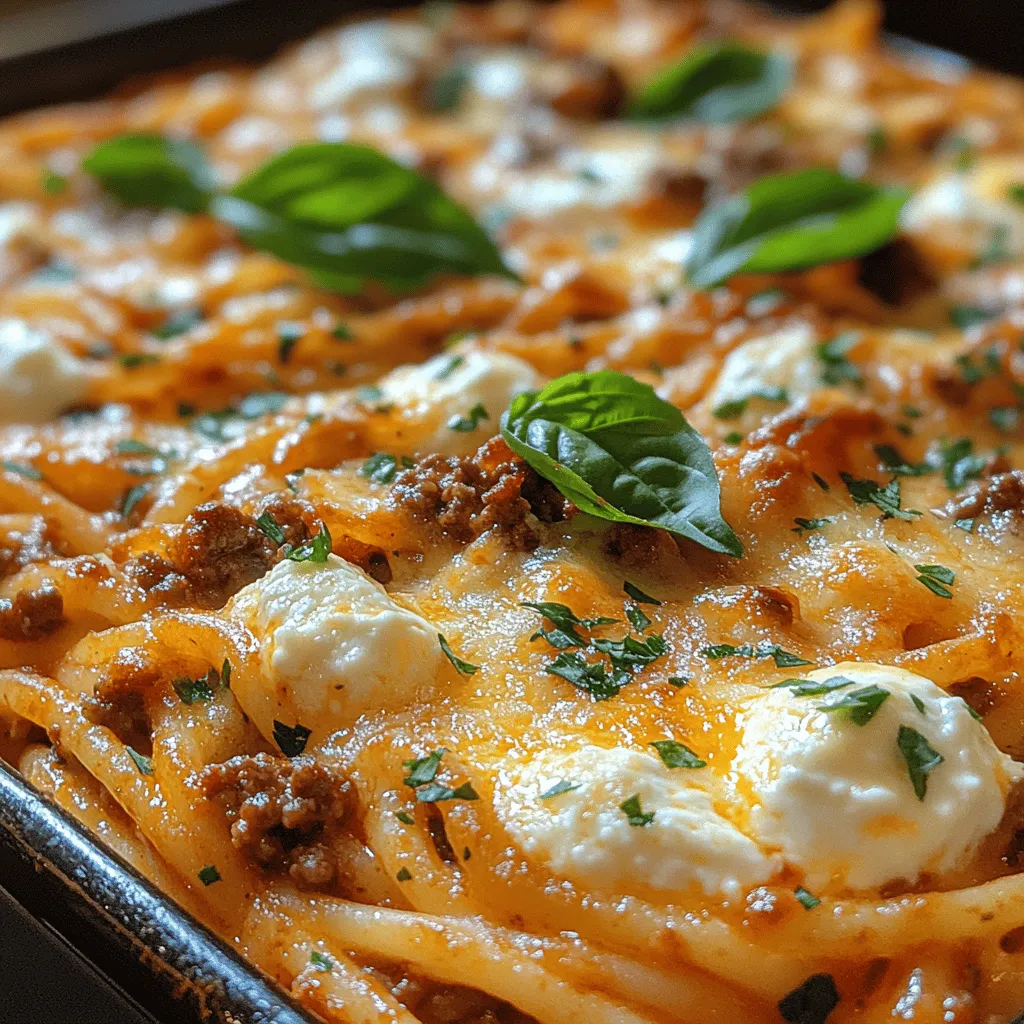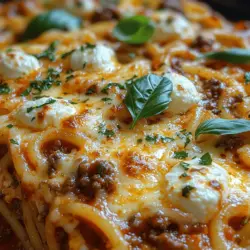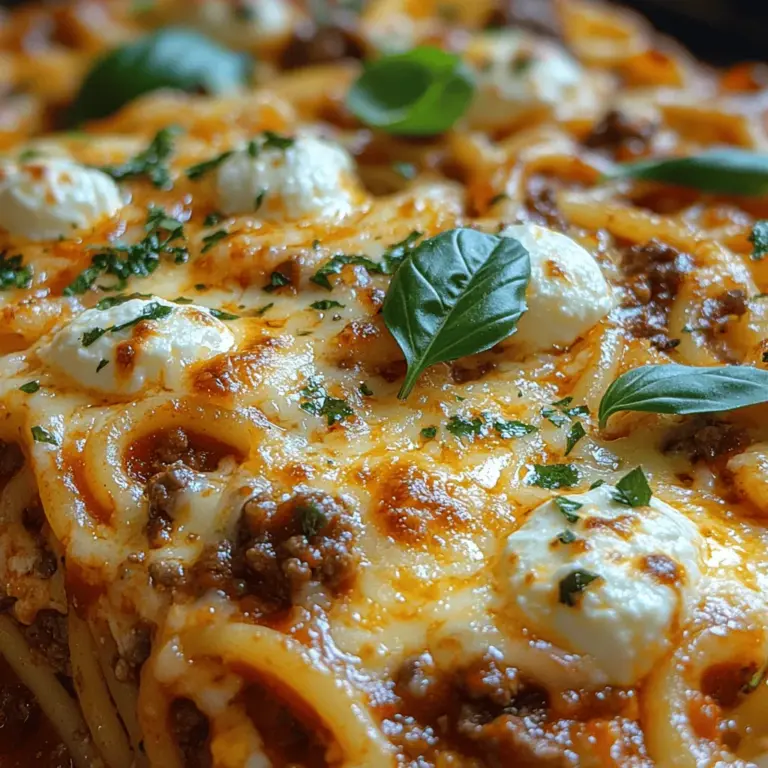Cheesy Delight: Baked Spaghetti Casserole with Three Cheeses
When it comes to comforting meals that bring families together, few dishes can rival the sheer joy of a Baked Spaghetti Casserole with Three Cheeses. This delightful recipe is not just a feast for the taste buds; it’s a warm hug on a plate, perfect for family gatherings, casual weeknight dinners, or any occasion where nourishment and comfort are paramount. The combination of al dente spaghetti enveloped in a rich, cheesy sauce makes this dish an irresistible choice for both kids and adults alike.
At the heart of this casserole’s appeal lies the generous use of cheese. Cheese not only enhances the overall flavor but also contributes a creamy texture that makes every bite a delight. Whether you’re a cheese lover or just someone looking for a hearty meal, this dish promises to deliver satisfaction. Additionally, its versatility allows for easy modifications; you can opt for ground beef or turkey, making it suitable for various dietary preferences.
Understanding the Ingredients
To appreciate the magic of Baked Spaghetti Casserole with Three Cheeses, it’s essential to understand the role of each ingredient that comes together in this dish. The foundation is, of course, spaghetti, which provides the structure and texture that holds the casserole together. Cooked just right, it offers a chewy base that perfectly complements the creamy cheeses and savory sauce.
Spaghetti: As the main component, spaghetti serves as the backbone of this casserole. It’s crucial to cook it until al dente, allowing it to maintain some firmness even after baking. This ensures that the pasta doesn’t become overly soggy in the oven, retaining its delightful texture.
Olive Oil: This essential ingredient does more than just prevent sticking; it enhances the flavor profile of the dish. A splash of good-quality olive oil not only helps in sautéing aromatic ingredients but also adds a rich, fruity note to the overall flavor.
Ground Beef or Turkey: As the protein source, ground beef or turkey adds heartiness to this casserole. Ground beef lends a robust flavor, while turkey offers a leaner option without sacrificing taste. Browning the meat correctly is crucial, as it develops a rich umami flavor that elevates the entire dish.
Crushed Tomatoes and Tomato Sauce: These ingredients create the base for our rich sauce. Crushed tomatoes provide texture and body, while tomato sauce adds depth and sweetness. Combined, they form a luscious sauce that envelops the pasta and meat, ensuring each bite is packed with flavor.
Herbs (Oregano and Basil): No Italian dish would be complete without the aromatic presence of herbs. Oregano and basil are staples that infuse the sauce with a robust flavor, adding a touch of authenticity that transports you straight to the heart of Italy.
Three Cheeses (Ricotta, Mozzarella, Parmesan): The star of this dish is undoubtedly the three cheeses. Ricotta, with its creamy consistency, adds richness and moisture to the casserole. Mozzarella, known for its meltability, provides that gooey, stretchy texture that is so satisfying. Finally, Parmesan brings a sharp, nutty flavor that balances the other cheeses and elevates the overall taste.
Fresh Basil: To finish off this cheesy delight, fresh basil adds a burst of freshness and color. It’s the perfect garnish that not only enhances the dish’s aesthetic appeal but also complements the flavors beautifully.
Preparation Steps Explained in Detail
Creating a Baked Spaghetti Casserole with Three Cheeses may seem daunting at first, but with a little preparation and attention to detail, you’ll find the process quite straightforward. Here’s how to get started:
Preheating the Oven: Begin by preheating your oven to 375°F (190°C). Proper temperature is essential for baking; it ensures that the casserole cooks evenly and that the cheese achieves that perfect golden-brown crust on top.
Cooking the Spaghetti: As your oven heats up, bring a large pot of salted water to a boil. Add the spaghetti and cook it according to the package directions, but aim for al dente, which means it should have a slight bite to it. This step is critical, as the spaghetti will continue to cook in the oven, and you don’t want it to become mushy.
Preparing the Sauce: While the spaghetti cooks, you can prepare the sauce. Start by heating a tablespoon of olive oil in a large skillet over medium heat.
Sautéing Onions and Garlic: Add finely chopped onions and minced garlic to the skillet. Sauté them until the onions are translucent and the garlic is fragrant, about 3-4 minutes. This step is crucial for maximizing flavor; the caramelization of the onions adds sweetness and depth to your sauce.
Browning the Meat: Next, add your choice of ground beef or turkey to the skillet. Use a wooden spoon to break it apart as it cooks. Browning the meat is essential; it develops those rich, savory flavors that form the backbone of your sauce. Cook until the meat is no longer pink, about 5-7 minutes.
Combining Tomatoes and Herbs: Once the meat is browned, add the crushed tomatoes and tomato sauce to the skillet. Stir in the dried oregano and basil, along with salt and pepper to taste. Allow the mixture to simmer for about 10-15 minutes. This simmering process melds the flavors together, creating a rich and savory sauce that will coat the spaghetti beautifully.
Combining Ingredients: After the sauce has simmered and thickened slightly, it’s time to combine everything. In a large mixing bowl, combine the cooked spaghetti with the sauce, ensuring that each strand is evenly coated. This is key for a flavorful casserole, as every bite should be infused with the delicious sauce.
With the ingredients prepared and combined, you’re well on your way to creating a mouth-watering Baked Spaghetti Casserole with Three Cheeses. In the next section, we’ll delve into the assembly and baking process that will transform these components into a bubbling, cheesy masterpiece. Stay tuned!

Layering the Casserole
Creating a delicious baked spaghetti casserole requires careful attention to the layering process. This critical step not only enhances the flavor but also contributes significantly to the texture of the dish. To achieve optimal cheese and spaghetti distribution, follow these techniques:
1. Start with a Base Layer: Begin by spreading a thin layer of the spaghetti sauce at the bottom of your baking dish. This will prevent the noodles from sticking and ensure even cooking.
2. Noodle Placement: When layering the spaghetti, gently toss it with some of the sauce before adding it to the dish. This helps to coat each strand, allowing for better flavor absorption throughout the casserole.
3. Cheese Distribution: Use a blend of cheeses in each layer. Start with a generous sprinkle of mozzarella, followed by ricotta dollops, and then a light dusting of Parmesan. This method creates pockets of flavor and ensures every bite is cheesy and satisfying.
4. Repeat Layers: Continue layering in this order—sauce, noodles, cheeses—until you reach the top of your baking dish. Aim for at least three layers to maximize flavor and texture.
5. Final Touch: For the top layer, finish with a thick layer of mozzarella and a sprinkle of Parmesan. This will create a beautifully browned and crispy crust when baked.
Importance of Layering for Flavor and Texture
Layering is essential in a baked spaghetti casserole for several reasons. First, it allows the flavors to meld together as they cook, creating a rich and harmonious taste profile. The different cheeses contribute varying levels of creaminess and sharpness, while the spaghetti absorbs the sauce’s flavor. Additionally, proper layering ensures that every serving contains a balanced amount of cheese, sauce, and pasta, preventing any one element from overpowering the others.
Visual Appeal of a Well-Layered Casserole
A well-layered casserole is not only a treat for the taste buds but also for the eyes. The contrasting colors of the red sauce, white cheese, and golden-brown crust create an inviting presentation. When the casserole is cut into, the layers reveal themselves, showcasing the delightful combination of textures. This visual appeal makes it an excellent dish for family gatherings or dinner parties, where the presentation is just as important as the taste.
Baking the Casserole
After meticulously layering your casserole, it’s time to bake it to perfection.
Covering and Baking: Explanation of How Covering Helps in Cooking
Preheat your oven to 350°F (175°C). Cover the baking dish with aluminum foil to help trap steam and moisture during the initial stages of baking. This step is crucial as it prevents the edges from burning while ensuring that the center cooks thoroughly. Baking covered allows the flavors to meld and the pasta to absorb the sauce, resulting in a tender and flavorful casserole.
Finishing Touches: Browning the Cheese for an Appetizing Look
After baking for approximately 30 minutes covered, carefully remove the foil. This step will allow the cheese on top to brown and become bubbly. Increase the oven temperature to 375°F (190°C) and bake for an additional 10-15 minutes or until the cheese is golden brown and crispy. This final touch not only enhances the flavor but also contributes to the appealing texture that everyone loves about baked pasta dishes.
Allowing to Rest Before Serving: Importance of Letting the Casserole Set
Once out of the oven, allow your baked spaghetti casserole to rest for at least 10-15 minutes before cutting and serving. This resting period is vital as it helps the layers set, making it easier to slice and serve without falling apart. Additionally, this pause enhances the flavors, allowing them to develop further as they cool slightly.
Nutritional Information
Understanding the nutritional components of your baked spaghetti casserole can help you appreciate its value as a hearty meal.
Breakdown of Key Nutritional Components
– Calories: A standard serving (1/6 of a 9×13 inch casserole) contains approximately 350-450 calories, depending on the specific ingredients used.
– Protein: Each serving can provide around 20-25 grams of protein, especially if you include meat in your casserole.
– Carbohydrates: The pasta contributes about 50-60 grams of carbohydrates, offering a good source of energy.
– Fats: With three types of cheese, expect a moderate fat content, primarily from saturated fats.
Benefits of Ingredients
– Protein from Meat: If you opt for ground beef or sausage, you’ll gain a substantial protein boost, which is essential for muscle repair and overall body function.
– Calcium from Cheese: The three-cheese blend not only creates a deliciously creamy texture but also provides a significant amount of calcium, which is important for bone health.
Cultural Context and Variations
Exploring the cultural background of the spaghetti casserole reveals its evolution from traditional Italian pasta dishes to a beloved comfort food across many kitchens.
Historical Background of Spaghetti Casserole and Its Evolution
The baked spaghetti casserole likely evolved from Italian-American cuisine, where pasta dishes were adapted to incorporate local ingredients and tastes. Over the decades, casseroles became a staple in American households due to their convenience and ability to serve multiple people. The dish has transformed into various interpretations, with families adding their unique twists along the way.
Regional Variations: How Different Cultures Interpret Baked Pasta Dishes
Different regions offer distinct takes on baked pasta. For instance, in the Southern United States, you might find a version that incorporates spices and Southern ingredients, while in the Midwest, casseroles often include cream soups for added richness. In Italy, pasta al forno is a traditional baked pasta dish, often layered with meats, cheeses, and béchamel sauce, showcasing the versatility of baked pasta across cultures.
Suggestions for Ingredient Swaps
To cater to different dietary preferences or to simply mix things up, consider these ingredient swaps:
– Vegetarian Options: Substitute the meat with sautéed vegetables like zucchini, mushrooms, and bell peppers, or use plant-based meat alternatives.
– Different Meat Choices: Ground turkey, chicken, or even Italian sausage can provide varied flavors and textures.
– Cheese Variations: Experiment with different cheese combinations such as gouda, fontina, or vegan cheese options for a tailored flavor profile.
Serving Suggestions
Pairing your baked spaghetti casserole with the right accompaniments can elevate the meal experience.
Ideal Accompaniments: Side Dishes and Drinks That Pair Well
Consider serving your casserole with a fresh side salad, featuring mixed greens, cherry tomatoes, and a light vinaigrette. Garlic bread is another classic accompaniment, perfect for soaking up any leftover sauce on your plate. For beverages, a glass of red wine pairs beautifully, enhancing the dish’s flavors, while sparkling water offers a refreshing contrast.
Best Practices for Serving: Tips for Presentation and Portioning
To serve, cut the casserole into even squares using a sharp knife. Use a spatula to lift each piece out of the dish carefully, ensuring you maintain the layers. Garnish each serving with freshly chopped parsley or basil for a pop of color and added flavor. This simple step adds an elegant touch to your presentation and encourages guests to enjoy not just the taste but the visual appeal of the dish.
Conclusion
The Cheesy Delight: Baked Spaghetti Casserole with Three Cheeses is more than just a meal; it’s a comforting experience that brings warmth to the table. With its rich layers of flavor, creamy texture, and the delightful crunch of browned cheese, this dish embodies the joy of cooking and sharing food with loved ones.
Encourage yourself and others to try this recipe, whether for a weeknight dinner or a special occasion. The versatility of this casserole allows for endless adaptations, inviting creativity in the kitchen. Embrace the joy that comes from preparing and enjoying a comforting meal, and share it with those you cherish.

